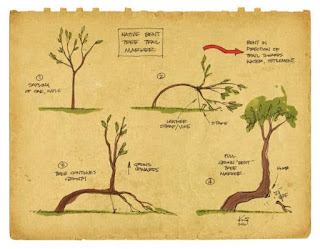trail marker trees 步道標記樹 L Tree
trail marker trees 步道標記樹 L Tree
北美印第安人會故意彎曲樹木作為道路上的標記,幫助他們在野外找到路與確認位置,作為導航之用
Trail trees, trail marker trees, crooked trees, prayer trees, thong trees, or culturally modified trees are hardwood trees throughout North America that Native Americans intentionally shaped with distinctive characteristics that convey that the tree was shaped by human activity rather than deformed by nature or disease.[1] A massive network of constructed pre-Columbian roads and trails have been well documented across the Americas, and in many places remnants can still be found of trails used by hunters and gatherers. One unique characteristic of the trail marker tree is a horizontal bend several feet off the ground, which makes it visible at greater distances, even in snow. Even today, modern hunters look for horizontal shapes while hunting deer, elk, and moose.[citation needed] Dr. Janssen noted in 1941:
Among the many crooked trees encountered, only a few are Indian trail markers. The casual observer often experiences difficulty in distinguishing between accidentally deformed trees and those ... purposely bent by the Indians. Deformities may occur in many ways. A large tree may fall upon a sapling, pinning it down for a sufficient length of time to establish a permanent bend. Lightning may split a trunk, causing a portion to fall or lean in such a way as to resemble an Indian marker. Wind, sleet snow or depredations by animals may cause accidental deformities in trees. However, such injuries leave scars which are apparent to the careful observer, and these may serve in distinguishing such trees from Indian trail markers.[2]
Large trees that exhibit deformed growth and distinctive forms bent in a vertical plane are sometimes labeled trail trees, marker trees, thong trees, or signal trees by enthusiasts. Historically, these unique trees were commonly known as Indian trail trees. Proponents of trail tree lore claim these unique forms are culturally modified trees used to mark trails or important places. Distinctively bent trees have long been noted throughout the Temperate Deciduous Forest of eastern North America.[3] The extent to which indigenous peoples used such trees as navigational aids, and whether such trees were formed by anthropogenic or natural means is controversial.[4][5]
These distinctively shaped trees have been photographed and documented in the Great Lakes Region by scientists and historians since the early 1800s.
The Nomad Survivalist
12月7日下午11:48 ·
I need to Caveat that: this also happens naturally, due to fallen trees, bending etc etc.
The L Tree Aka, Trail trees, trail marker trees, crooked trees, prayer trees, thong trees
Many years ago, these trees were purposefully bent, and their odd shapes communicate very important messages.
No more than four or five feet off the ground, these trees bend sharply into right angles, parallel the earth for a measure, and turn sharply up again, towards the sky. These trees are now abandoned infrastructure. Like other structural relics, they were designed to be long-lasting so much so that some of these trees are still indicating the way. But the people they served have been forced to leave, and the marker trees themselves are in danger of disappearing.
The trees look like that because native tribes had purposefully shaped them to mark trails through the woods and across the water.
Having the knowledge of these trail trees could mean the difference between life and death, between eating and starving, between crossing the river correctly or incorrectly.
我需要警告: 這也自然發生, 因為倒下的樹木, 彎曲等.
L樹 又名, 小徑樹, 拖車樹, 歪樹, 禱告樹, 丁字褲樹
多年前, 這些樹木故意彎曲, 它們奇怪的形狀傳遞了非常重要的訊息.
離地面不超過四到五英尺, 這些樹木急速向右角彎曲, 平行地球, 再一次向天空顯現. 這些樹現在被遺棄的基礎設施. 像其他結構性遺跡一樣, 它們的設計是長久的, 以至於其中一些樹木仍然指明道路. 但是他們所服務的人被迫離開, 標記樹本身也面臨消失的危險.
這些樹看起來像這樣, 因為原住民部落故意塑造它們, 以標記穿過樹林和穿過水域的小徑.
瞭解這些樹木可能意味著生死, 吃食和飢餓, 過河之間的區別, 正確或錯誤地過河之間的區別.
資料來源:
https://en.wikipedia.org/wiki/Trail_trees
fb: The Nomad Survivalist










0 意見:
張貼留言